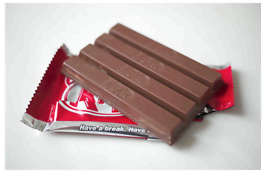On 20 January 2016, the UK High Court concluded that, under the Case No. CH/2014/0392, CH/2013/0394, the shape of KIT KAT chocolate bar was not registrable as a trademark because lacking of distinctiveness.
THE ACTUAL
Trademark application for the mark “ ” in the UK
On 8 July 2010, Société des Produits Nestlé SA (“Nestlé”) applied to register the three dimensional sign graphically represented below as a United Kingdom trademark in respect of various goods in Class 30 under UK trademark No. UK00002552692:
The filed trademark corresponds to the shape of Nestlé’s four-finger KIT KAT product but lacking of the phrase “KIT KAT” on each finger of the actual products as follows:

Opposition of a third party against the registration of the three dimensional trademark of Nestlé
Cadbury UK Ltd (“Cadbury”) has filed an opposition against the registration of the three dimensional trademark of Nestlé based on the reason that the mark lacks of inherent distinctiveness. Nestlé has filed a counterclaim to the Cadbury’s opposition by asserting that their three dimensional trademark had become distinctive at the relevant date by virtue of acquired distinctiveness.
The hearing officer concluded the applicant had shown recognition of the three dimensional trademark amongst a significant proportion of the relevant public for chocolate confectionery but not that consumers relied on the shape to identify the origin of the goods. The key factors were:
i) There was no evidence that the shape of the product has been featured in the Nestlé’s promotions for its goods for many years prior to the date of the application;
ii) The product was sold in an opaque wrapper and the wrapper did not show the shape of the goods;
iii) There is no evidence – and it did not seem likely – that consumers used the shape of the goods post purchase in order to check that they had chosen the product from their intended trade source.
Therefore, it is likely that consumers only rely on the word mark “KIT KAT” and the other distinctive elements used in relation to the goods in order to identify the trade origin of the goods. They associated the shape with KIT KAT and therefore with Nestlé.
Based on the reason that the consumers does not rely on the shape of the goods inside the package to have decisions to purchase the goods, the claim of acquired distinctiveness by Nestlé failed.
Appeal of Nestlé
Nestlé appealed against the decision to the U.K. High Court. The court decided that it was necessary to seek clarification of the law from the Court of Justice of the European Union in order to determine the appeal. Finally, the judge determined that in order to demonstrate that a trademark has acquired distinctive characters, the applicant must prove that, at the relevant date, numbers of consumers perceive the goods as they are actually seen when having decision to purchase the goods.
With this approaching, the U.K. High Court agreed with the hearing officer’s decision of the UKIPO and dismissed the appeal of Nestlé.
---
Van Anh – Vietthink Law Firm
_____________
Reference:
- Article of John McKeown of Goldman Sloan Nash & Haber LLP;
- Decision of the U.K. High Court for Case No: CH/2014/0392, CH/2013/0394 issued on 20 January 2016.